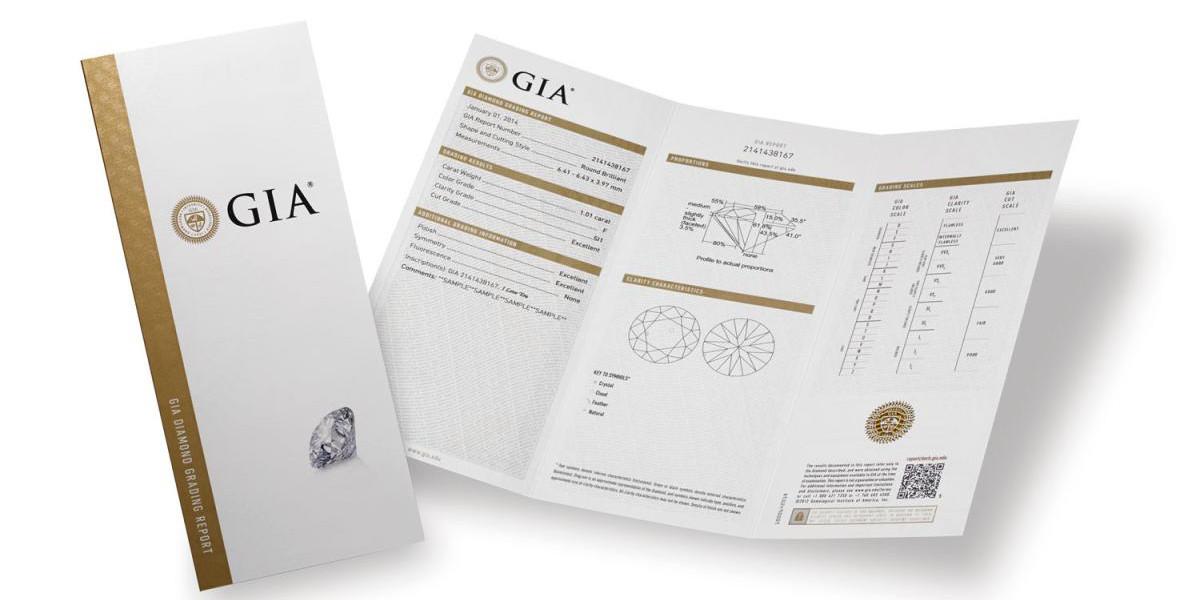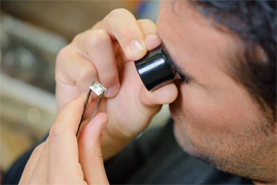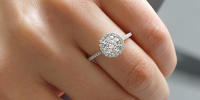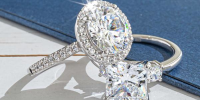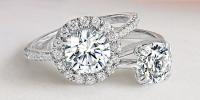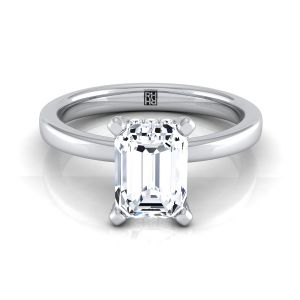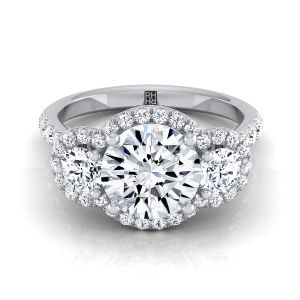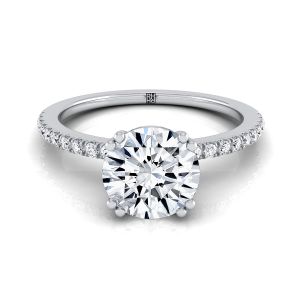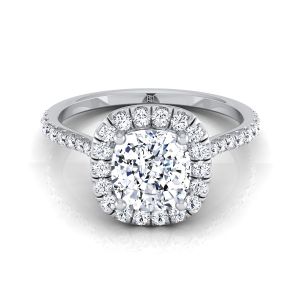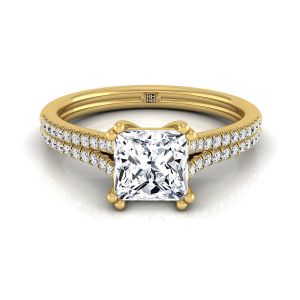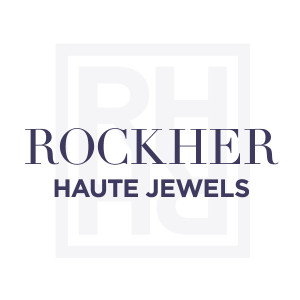If you are buying a significant diamond or engagement ring, a grading report from an independent and objective third party can help verify its quality and value. A grading report levels the playing field between retailers to help you compare diamond prices while you are shopping for a diamond ring, engagement ring, or other jewelry with significant diamonds.
A diamond grading report, popularly referred to as a “diamond certificate,” diamond laboratory report, diamond dossier, diamond quality document, or diamond light performance report, gives you a description of the 4Cs of diamond quality – color grade, clarity grade, cut evaluation, and carat weight − and can be used to identify an individual stone, like an ID card. A diamond grading report will also confirm if a diamond is natural or lab-grown and disclose if there are any diamond treatments like heating or laser drilling. Along with a girdle inscription, it confirms that the diamond you are paying for is the one you are getting.
A reputable diamond grading report also helps you to identify your diamond if you ever have to repair or sell it. It also ensures you will receive the same quality replacement if it is ever lost or stolen: insurance companies use your diamond report to determine the quality of your replacement diamond.
Diamond Grading Reports vs Diamond Appraisals
A report isn’t an appraisal: it describes your diamond, it doesn’t give you an estimate of a diamond price (which can change over time.) Some retailers will give you an appraisal from the store or from a local individual who works with the store. But an appraisal can’t replace a grading report. Because the appraisal isn’t from a nationally known institution or from an independent authority, it doesn’t really confirm the quality of the diamond or gem, which is what the diamond price is based on.
You can find reputable independent appraisers through the American Society of Appraisers or the National Association of Jewelry Appraisers.)
Why You Need the Right Diamond Grading Report
Diamond grading is opinion and there isn’t one consistent diamond grading system that defines what a G color grade is or what a VS1 orVS2 clarity grade looks like. One lab could call a diamond an H color grade and another could call it an F color grade. That difference in color grading actually happens all the time: so do differences in clarity grading and cut grading. Some are honest differences of opinion and some are part of a lab’s overall policy: some labs grade more leniently because it makes them more popular with dealers and retailers.
That’s why it’s vitally important to choose a diamond that’s graded by the right diamond laboratory. Not all diamond grading report are the same. They are only as valuable as the reputation of the lab that issues them. Diamond professionals don’t consider lab reports from different labs to be the same when evaluate diamonds. The name of the laboratory on a lab report can result in hundreds or thousands of dollars difference in diamond prices. Picking the wrong lab can cost you a lot of money and result in you buying a stone that’s not really the high-quality diamond you think it is.
If you are comparing two H color and SI1 clarity diamonds with excellent cut grades you might be tempted to pick the one with the lower price. But if one of the diamonds has a diamond grading report from a lab that inflates its color grades and clarity grades, you can’t really compare them as equals. One might actually be a J SI2 diamond that’s overgraded and overpriced, not an H SI1 that’s a good deal.
If a retailer tells you that you don’t need a diamond grading report from GIA or AGS, it’s probably because they are trying to pull the wool over your eyes and sell you a diamond “deal” that’s been overgraded by a less reputable lab.
Don’t take any diamond lab report seriously if it isn’t from one of the diamond laboratories listed below (and read what we say about each diamond laboratory before you choose a diamond with a report from that lab.) An accurate diamond grading report will be issued on a loose diamond, not on a complete diamond ring or engagement ring.
In this guide, we’ll give you information and opinions about all the most common diamond grading reports so you never make a thousand-dollar diamond report mistake.
GIA: The Gemological Institute of America
GIA diamond grading reports are the gold standard. Founded in 1931 as a non-profit educational institution, GIA invented the diamond grading scale for color grading and clarity grading that everyone in the world uses to describe diamond quality. GIA educates most of the gemologists who grade diamonds in the United States.
A diamond with a GIA report isn’t valued more because the GIA is the biggest diamond grading laboratory or the oldest diamond-grading laboratory. GIA reports are the most well-respected in the world because GIA is the most consistent laboratory with extensive safeguards in place to keep graders objective. GIA is a non-profit so it doesn’t benefit from its commercial relationships with diamond dealers or retailers. In addition to being the most important lab for colorless diamond grading, GIA also leads the world in grading fancy color diamonds too.
GIA grading reports are more expensive than competing labs, ranging from $120-$80 for a colorless one-carat diamond (larger stones are more, smaller stones less.) GIA’s main drawback is that it can sometimes take a few weeks (or even longer) to receive a report.
Because GIA is the global diamond grading benchmark, diamonds with a GIA grading report sell for the highest price of any laboratory. The market trusts grades from GIA more than any other lab. RockHer only sells diamonds with GIA reports.
AGS: American Gem Society Laboratories
The American Gem Society was founded in 1934 by Robert M. Shipley, the same gemological pioneer who founded GIA, as a non-profit association of independent jewelry retailers. AGS requires member jewelers to have a gemological education and uphold high standards of integrity. AGS founded its own diamond-grading laboratory in 1996 in order to offer the world’s first diamond cut grades. AGS has the world’s most well-respected diamond cut quality grades: if you want to buy an “ideal cut” diamond with a hearts and arrows cut, you need an AGS grading report.
AGS cut grades are based on light performance, evaluated by a ray-tracing tool called ASET, rather than proportions. That means that AGS can offer cut grades for some fancy cut diamonds as well as rounds, including princess, emerald cut and oval diamonds.
AGS uses a 0-10 scale for diamond grades, with 0 being best, rather than the common GIA-invented D-Z color grading, Fl-I clarity grading system used by most other labs. The best grade is known as a “triple zero,” which is a perfectly cut diamond. AGS grading reports are considered to have the same high quality as GIA reports by the market. Some dealers view AGS as slightly stricter than GIA for clarity grading and slightly looser on color grading but these differences will probably only be noticed on diamonds on the border between two grades.
IGI: International Gemological Institute
IGI became one of the largest diamond grading laboratories in the world by serving major chain retailers. IGI created the credit card diamond reports used as tools to help sell diamond rings in national mall jewelers. In 1981, IGI also added diamond and jewelry appraisals that show inflated retail values to help retailers sell their products.
This points to the inherent problem with for-profit labs: you are not the lab’s customer, the seller is. As a result, IGI creates a grading system with reports that sell jewelry, they don’t create reports that protect consumers.
Retailers want to show you diamonds with high grades at low prices, giving IGI an incentive to overgrade diamonds. That’s good for business: IGI has locations in New York, Bangkok, Mumbai, Tokyo and Antwerp, issuing 400,000 diamond and jewelry reports a year. Diamonds with IGI reports sell for a discount in the trade because of its reputation for a grading system that overstates diamond quality.
GSI: Gemological Science International
GSI is a for-profit lab that was founded in New York by the former CEO of IGI and it has a similar business model and diamond grading system. GSI diamond grading reports are created as a sales tool for major retailers including the country’s largest chain stores. In fact GSI has a laboratory in Akron, Ohio to serve Signet, the nation’s largest specialty jeweler. Because jewelers and diamond dealers are GSI’s customers, they have an incentive to grade their customer’s diamonds as high as possible. That’s why we don't recommend relying on GSI grading reports when buying a diamond or diamond ring.
EGL: European Gemological Laboratories
EGL grading reports are from a network of gemological laboratories around the world, including the United States, Canada, Israel, India, and South Africa. Ironically, desite its name, none of the EGL labs is actually in Europe. EGL USA has locations in New York, Los Angeles, Vancouver, and Toronto. Each of these for-profit labs is independently operated which leads to differences in grading standards.
The lack in consistency and overgrading by different EGL labs led to the largest diamond trading network, Rapnet, banning the sale of diamonds with EGL reports. EGL has a reputation for inflated grading. Although EGL USA has a better reputation than EGL labs in other countries, we can’t recommend choosing a diamond based on an EGL grading report because it will sell at a significant discount to a diamond with a GIA report.
That’s because EGL has more lenient grades for color, clarity, and cut. An ideal cut diamond certified by the EGL might only receive a good cut grade by AGS or GIA. In addition, EGL labs offer preliminary reports to dealers: if they don’t like the grades they will receive, they don't have to pay for a full grading report. This gives EGL an incentive to offer grades that diamond dealers will like. That’s why we do not recommend purchasing diamonds with EGL reports.
GHI: Gemology Headquarters International Laboratory
GHI laboratory in New York is owned by the same people as EGL. After EGL was banned from Rapnet, its business dropped off significantly. Owners and managers of the lab founded GHI as a new laboratory without the baggage and bad publicity of the EGL name. Diamonds with GHI reports can be listed on Rapnet. Is GHI the same as EGL? We wouldn’t buy a diamond based on a GHI report because we have to assume that the business model is the same as EGL and the diamonds may in fact be graded by the same exact diamond graders.
IIDGR: International Institute of Diamond Grading & Research
IIDGR was only founded in 2008 but it had instant gravitas because it’s part of the De Beers Group, the world’s most important diamond miner and supplier of rough diamonds (as well as the creator of the diamond marketing campaign that invented “A Diamond is Forever” and the engagement ring tradition.) IIDGR has three locations currently: Maidenhead in the UK (the home of De Beers research facilities), Antwerp and Surat, India. De Beers research created most of the scientific instruments that labs all over the world (including GIA) use to separate natural from lab-grown diamonds. IIDGR’s reputation is good but you are unlikely to see its grading reports in the United States market unless you purchase a Forevermark Diamond, the De Beers diamond brand. The Forevermark Diamond Institute is basically the same thing as the IIDGR: Every Forevermark Diamond is sold with a custom Forevermark grading report from IIDGR.
HRD: Diamond High Council
HRD or Hoge Raad voor Diamant , the Diamond High Council, is a leading laboratory in Antwerp, an international center of the diamond trade in Europe. Although HRD is not well known in the United States it is a very important lab in Europe. HRD is a non-profit laboratory founded in 1976 to serve the Belgian diamond industry. Although it has a good reputation, you can expect diamonds with HRD grading reports to sell for a discount to diamonds with GIA grading reports because as an industry promotional organization (rather than a consumer protection organization) they grade a bit higher. HRD also uses some different grading terminology, labeling high-clarity diamonds “loupe clean” rather than flawless or internally flawless and labeling “I” included diamonds P1 to P3 or pique diamonds.
GCAL: Gem Certification & Assurance Lab
The most well-known of the smaller labs, GCAL was founded in New York in 2000. GCAL is the only laboratory that guarantees its diamond color and clarity grades for two years with cash back for the difference in quality (although GCAL is the one who decides if the color or clarity grade is not accurate and they charge you a fee to challenge the grading report so this is pretty limited in scope.) GCAL creates custom documents for retailers that communicate additional information like hearts and arrows images. All GCAL reports include a making a Gemprint of the diamond, a laser fingerprint of the diamond that can be used to identify it if lost or stolen. Some insurance companies offer discounts for diamonds with a Gemprint. Although GCAL is respected, it isn’t well known and so we don’t recommend it as a primary report.
PGS: Professional Gem Sciences Laboratory
One of the few small laboratories that can be listed on Rapnet, PGS is the leading gem lab in Chicago. Founded by Tom Tashey, the original inventor of the SI3 clarity grade, PGS has a good reputation for accuracy, although its diamond grading reports are not well-known outside of the Midwest, which is a disadvantage. They also provide reports and appraisals of finished jewelry.
Supplemental Diamond Grading Reports
Sometimes your diamond grading report comes with a second supplemental report. GemEx diamond reports add information on a diamond’s light performance. This is especially helpful for hearts and arrows and other ideal cut diamonds. Sarine reports provide very detailed dimensions, combining this with light performance prediction software by AGS and GIA to estimate the diamond cut grade. Sarine is the world’s leading manufacturer of diamond assessment equipment. Diamond cutters use Sarine machines to assess diamond rough in three dimensions and plan the size and shape of cut stones. Detailed measurement of polished gems is simple in comparison. Sarine also produces Diamond Journey reports that show the step-by-step evolution of a diamond, from rough to cut.
Other Major Overseas Labs
Shipping diamonds around the world for grading is expensive and time-consuming. That’s why there are strong well-regarded diamond grading labs around the world that serve local markets.
CGL, Central Gem Laboratories, is a well-respected gem laboratory in Japan with seven locations founded in 1970. It’s the leading lab in the Japanese market. Like GIA, CGL provides gemology education, develops gem instruments including the world’s first cape series detector and publishes gemological research. Diamonds graded by CGL generally sell for the same as GIA and AGS diamonds in the Japanese market.
If you are in Australia, you may see diamonds graded by DCLA, the Diamond Certification Laboratory of Australia. In China, the leading lab is NGTC, the National Gem Testing Center. In Dubai, IDL, International Diamond Laboratories is sponsored by the Dubai Diamond Exchange and the Dubai Multi Commodities Centre. These laboratories are national rather than international so you are unlikely to encounter diamond grading reports from these labs in the United States or Europe.
Major Colored Gemstone Laboratories
The most well-known colored gemstone laboratories are not the same as the leading diamond laboratories. Although GIA does issue well-regarded reports on colored gemstones, it was a long time before it began to issue the origin reports that auction houses and high-end dealers use to document where a gemstone was mined. As a result, other labs became the benchmark for origin certification. The most well-known colored gemstone laboratory is Gubelin in Geneva. SSEF, the Swiss Gemmological Institute, is also very well-regarded and has pioneered the use of high-tech equipment. In New York, AGL, or American Gemological Laboratories, is also well-known for origin reports. You are most likely to see colored gemstone origin reports from these three labs referenced in auction catalogs.
Other Laboratories
We constantly get inquiries about other diamond grading reports from an alphabet soup of impressive-sounding laboratories that no one has ever heard of: ADL, DIA, GIE, GGS or SGL. Labs like IGL and TIG often grade clarity enhanced diamonds and lab-grown diamonds, which GIA and AGS do not grade. Many these labs are small one-person appraisal practices with varying levels of expertise. Some may be honest and excellent and some may be schemers. It doesn’t even matter: no professional would trust a diamond grading report from one of these labs to confirm the quality of a diamond, compare a diamond price, or to insure a diamond and you shouldn’t either.
It’s just too common for these “labs” to produce meaningless documents to help sell you something you shouldn’t be buying. We can’t even trust these reports to accept your diamond to create a custom ring or repair your piece because we don’t know if they are hiding something serious like fracture filling or huge inclusions that make a diamond vulnerable to damage. So do yourself a favor and don't buy a significant diamond without one of the reports listed in this guide.
The Bottom Line
We recommend GIA or AGS above all others because they are the most well-respected and well-known diamond grading reports in the world.










